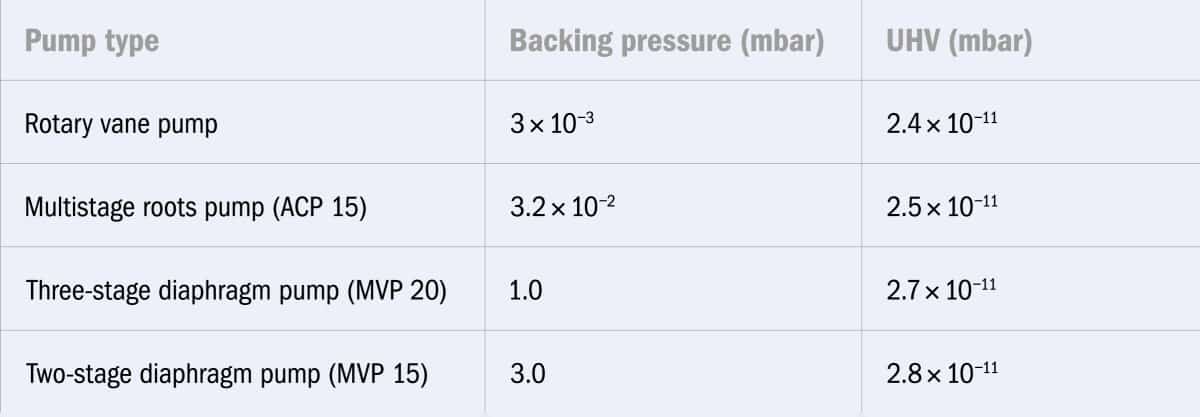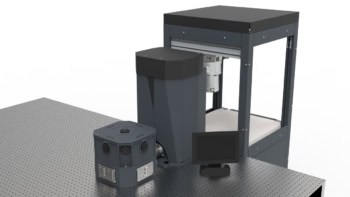An in-house experimental study by Pfeiffer Vacuum makes the case for an innovative approach to the pump-down of ultrahigh-vacuum (UHV) systems

Nothing, it seems, can sometimes be everything – at least in frontline scientific research. Ultrahigh vacuum – broadly the “nothingness” defined by the pressure range spanning 10−7 mbar (hPa) through 10−12 mbar – is a case in point. UHV is an umbrella term for a suite of enabling technologies deployed in all manner of fundamental research endeavours: from particle accelerators and gravitational wave detectors to cold-atom physics experiments and scanning force microscopes. At the same time, UHV conditions ensure that scientists are able to probe – using photons, electrons or ions – chemically clean sample surfaces free from any unwanted adsorbates – also a must-have requirement for advanced thin-film growth and preparation techniques such as molecular-beam epitaxy and pulsed laser deposition.
What all of these applications have in common is the need for a holistic approach to vacuum system design in order to routinely deliver – and maintain – the necessarily rarefied and extreme UHV environment. In short, the entire vacuum system needs to be planned and configured along multiple coordinates such that the vacuum chamber, pumps, pressure gauges, connections, leak detection and software control are all optimized as part of a joined-up UHV infrastructure, rather than being treated as isolated components.
Too many choices?
Unfortunately, that’s easier said than done. Zoom in a little closer and it’s evident that vacuum end-users are confronted with no shortage of technology options – all of them with their own pros and cons – when it comes to specifying the core building blocks of a UHV system. Perhaps most fundamentally, the selection of the optimum pumping set-up is far from straightforward, with the need to weigh up capital/operational costs, energy consumption, size and footprint, maintenance intervals and environmental impacts (noise/vibration).
That picture is complicated further by the multiplicity of choices regarding the ideal combination of main pump (ion getter pump versus titanium sublimation pump versus turbomolecular pump versus cryopump) and backing pump (diaphragm pump or rotary vane pump or multistage Roots pump) used to generate UHV conditions – in some cases via rapid evacuation of the vacuum chamber, in others via adsorption of any lingering gas species.

Now, an R&D team at Pfeiffer Vacuum, a German manufacturer of specialist vacuum systems and components, has published the results of an in-house study that points the way to simpler and more economical pumping set-ups for diverse UHV research applications – whether that’s in small-scale surface-science laboratories or the accelerator complexes of big-science facilities. In short, Pfeiffer Vacuum scientists have shown that it’s possible to routinely generate low-UHV conditions (of the order of 10−11 mbar) by pairing a high-compression-ratio turbopump (in this case the vendor’s HiPace 300 H) with a suitable dry backing pump. Key to the breakthrough is figuring out an effective way to remove the dominant residual gas species – chiefly hydrogen – from the vacuum chamber during draw-down to the UHV regime.
“The back-streaming of hydrogen versus pumping direction of the turbopump has traditionally been the biggest limiting factor when it comes to reaching very low UHV pressures,” explains Andreas Schopphoff, head of market segment R&D at Pfeiffer Vacuum. “So as soon as we get a higher compression ratio – and in turn reduce that back-streaming effect – we’re able to generate much lower pressures than we’ve managed in the past.”
UHV under scrutiny
The deployment of high-compression-ratio turbopumps in this way represents a win-win for UHV system innovation, claims Schopphoff. Most notably, upfront investment and cost of ownership are favourable when compared with conventional approaches to UHV generation (for example, the use of an ion getter pump in tandem with a turbopump, with the latter deployed as backing pump). The new approach is also a lot simpler in terms of implementation, field maintenance and service intervals (typically longer than four years). “As such, this is a pumping set-up that will suit scientific users who want a UHV system that pulls the vacuum and is 100% reliable, 100% of the time,” Schopphoff explains. “It’s also one switch to do it all, with a single programmable controller to drive the turbopump and the dry backing pump.”
In their experimental study, the Pfeiffer Vacuum team used a small-scale vacuum chamber (500 mm diameter, 120 mm high) that was baked for seven days at 120 °C. The scientists then evaluated the UHV performance of the HiPace 300 H turbopump (hydrogen compression ratio ≥1×107) when paired with four separate dry backing pumps (a rotary vane pump; a multistage Roots pump; as well as a two-stage and three-stage diaphragm pump). The time span for each measurement was one day, using hot-cathode and cold-cathode ionization gauges to track chamber evacuation for each backing/main pump pair (see Table 1).

“For relatively simple vacuum chambers, like the one here in our lab, we found that even a small diaphragm pump is sufficient as the backing pump in combination with the HiPace 300 H,” says Schopphoff. His team also concluded that a multistage Roots pump (in this case Pfeiffer Vacuum’s ACP 15) in tandem with the HiPace 300 H provides an ideal backing/main pump combination to generate low UHV conditions for chambers of 100 L capacity or more.
“This is particularly relevant in a big-science context,” Schopphoff adds, “where users need to generate UHV in the vacuum tubing of a particle accelerator without particulate contamination from the pumping system.” In fact, for an accelerator setting he reckons the optimum set-up would see the HiPace 300 H paired with Pfeiffer Vacuum’s ACP 28 or ACP 40 multistage Roots backing pumps – both of which are fluorine-free and can operate with an extended cable connection of up to 120 m between the control electronics and pump location (to keep the electronics away from harsh radiation environments).
Right now, the priority for Schopphoff and his colleagues is to educate Pfeiffer Vacuum’s R&D customer base about the merits of UHV generation using high-compression-ratio turbopumps – specifically, the HiPace 300 H and its sister product the HiPace 700 H (with hydrogen compression ratio ≥2×107). The company’s webinars on the subject have been well received by the research community, with most of the commercial interest to date coming from university-based vacuum customers.
“The HiPace 300 H is a really good pumping option for UHV, but we’re still trying to make it better,” notes Schopphoff. “Ultimately, our job is to come up with vacuum innovations that make life easier for our R&D customers. This is a solution that does just that.”




